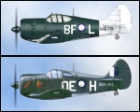stldiver
Posts: 724
Joined: 7/6/2006
From: West Palm Beach, USA
Status: offline

|
Nov 6th 1942
Flight leader Sagara was in the lead Nell, they were cruising at over 10,000 ft it was cold, very cold. The plane vibrated to the rhythm of the engines. They had been alerted at dawn by the 44th Naval Guard that Canadian troops were landing on Umnak. The crews tumbled out of bed and immediately began warming up the planes. What desperate measures the allies had gone to, trying to invade in this cold. Did they think we would not be on alert!.
Umnak had but one garrison the 44th Naval Guards. They always had reported that 3 Liberators bombed them daily, aside from that there had been no activity by both sides for several months.
Slowly the island appeared on the Horizon, then they spotted the enemy force. There were only 4 transports. Sagara scanned the ocean there must be more, where were the escorts, what madness. Seeing nothing more he began his descent targeting the lead ship, they were all stopped and unloading troops. The Nell skimmed above the waters and released its torpedo, which ran straight towards the transport, he gave the plane full throttle and began the climb as the enemys anti-aircraft fire began to sound. Then the transport lifted out of water as the 1st torpedo struck.
As Sagara climbed back into the sky, he watch the 4 ships slip beneath the waves, by his count they had lost one plane to anti-aircraft. In the water he witnessed the enemy troops quickly dieing from the cold.
There job was over it was now time for the 44th to evict the ones that made it ashore.
--------------------------------------------------------------------------------
Morning Air attack on TF, near Umnak Island at 169,51
Weather in hex: Overcast
Raid spotted at 39 NM, estimated altitude 16,000 feet.
Estimated time to target is 15 minutes
Japanese aircraft
G3M2 Nell x 28
No Japanese losses
Allied Ships
xAK San Lucas, Torpedo hits 2, and is sunk
xAK Charles McCormick, Torpedo hits 3, and is sunk
xAK Cape Flattery, Torpedo hits 2, and is sunk
xAK Mormacmar, Torpedo hits 2, and is sunk
Allied ground losses:
540 casualties reported
Squads: 0 destroyed, 11 disabled
Non Combat: 4 destroyed, 87 disabled
Engineers: 0 destroyed, 2 disabled
Guns lost 4 (0 destroyed, 4 disabled)
Vehicles lost 9 (4 destroyed, 5 disabled)
Aircraft Attacking:
28 x G3M2 Nell launching torpedoes at 200 feet
Naval Attack: 1 x 18in Type 91 Torpedo
--------------------------------------------------------------------------------
Ground combat at Umnak Island (169,51)
Japanese Bombardment attack
Attacking force 1326 troops, 11 guns, 0 vehicles, Assault Value = 53
Defending force 558 troops, 0 guns, 0 vehicles, Assault Value = 49
Assaulting units:
44th Naval Guard Unit
Defending units:
13th Canadian Bde /5
Historical Fact:
Umnak (Unmax[2] in Aleut) is one of the Fox Islands of the Aleutian Islands. With 686.01 square miles (1,776.76 km2) of land area, it is the third largest island in the Aleutian archipelago and the 19th largest island in the United States. The island is home to a large volcanic caldera on Mount Okmok and is separated from Unalaska Island by Umnak Pass.
As of the 2000 census,[1] the island had a population of 39 persons. Its only remaining community, Nikolski, comprised the island's entire population. Fort Glenn, a former major military facility on the northeast shore of the island, played an instrumental role in the North Pacific Theater in World War II.
Cape Field at Fort Glenn also known as Umnak Airport, is a site significant for its role in World War II fighting. It "provided aerial defensive cover for the U.S. bases in Unalaska Bay"[2] and "is the most comprehensive and intact World War II base in the Aleutian Islands"[3] It is located on Umnak Island in the Aleutian Islands.
"Constructed between January and April 1942, Cape Field's first runway was then the U.S. Army's most westerly airfield in the Aleutian Islands."[2][3] "In June 1942 aircraft from Cape Field participated in a counterattack after the Japanese attacked the Dutch Harbor naval and army installations on nearby Amaknak Island."[3] It "also served as the initial forward base to launch bombing attacks on Japanese installations on Attu and Kiska" islands.[2]
"By the close of 1942, Fort Glenn had 10,579 personnel, but its role as an advanced air base had been supplanted by facilities on Adak Island farther to the west. Buildings, runways, and World War II artillery emplacements remain."[3][2] It was decommissioned in 1950.
|
 Printable Version
Printable Version

































 New Messages
New Messages No New Messages
No New Messages Hot Topic w/ New Messages
Hot Topic w/ New Messages Hot Topic w/o New Messages
Hot Topic w/o New Messages Locked w/ New Messages
Locked w/ New Messages Locked w/o New Messages
Locked w/o New Messages Post New Thread
Post New Thread